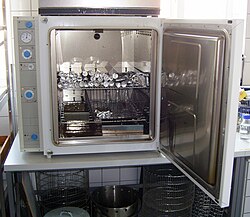Asepsis
(Redirected from Aseptic technique)
Asepsis
Asepsis refers to the absence of infection or the absence of infectious organisms. In medical and surgical fields, asepsis is crucial for preventing the spread of infections, ensuring the safety of patients and healthcare workers alike. It encompasses methods to establish a microorganism-free environment, even in settings where contamination is a significant risk.
Overview
Asepsis aims to prevent contamination by microorganisms, ensuring sterile conditions on tissues, materials, and within specific environments, such as operating rooms. This is achieved by various means including excluding, removing, or destroying pathogenic organisms.
Principles
The two primary principles of asepsis are:
- Medical Asepsis: Reducing the number of organisms and preventing their spread.
- Surgical Asepsis: Ensuring a completely microorganism-free environment, particularly relevant during surgical procedures.
Techniques for Achieving Asepsis
Sterilization
A process that eliminates all forms of microbial life, including bacteria, viruses, spores, and fungi. Common methods include:
- Autoclave: Steam under pressure.
- Dry heat sterilization: Oven or furnace.
- Gas sterilization: Ethylene oxide or hydrogen peroxide.
- Radiation: Gamma rays or ultraviolet radiation.
Disinfection
Unlike sterilization, disinfection eliminates most, but not all, harmful microorganisms. Examples include:
- Chemical disinfectants like alcohol, bleach, or hydrogen peroxide.
- Boiling materials in water for a specific duration.
- Ultraviolet light exposure.
Antisepsis
Involves applying antiseptics (chemical agents) to living tissues to reduce the possibility of infection. Common antiseptics include iodine solutions and hydrogen peroxide.
Barrier Techniques
Using barriers like gloves, gowns, masks, and protective eyewear to prevent direct contact with potentially contaminated materials.
Applications
- Surgery: Ensuring all surgical instruments, the operating field, and the environment are sterile.
- Wound Care: Keeping wounds clean and free from harmful microorganisms to promote healing.
- Intravenous Therapy: Ensuring the sterile administration of IV fluids and medications.
- Laboratory Work: Preventing contamination of samples and culture media.
Importance
Aseptic techniques are paramount in healthcare settings to:
- Minimize the risk of infections.
- Promote faster recovery for patients.
- Protect healthcare workers from potential infections.
- Ensure the validity and reliability of laboratory results.
See Also
References
Transform your life with W8MD's budget GLP-1 injections from $125.
W8MD offers a medical weight loss program to lose weight in Philadelphia. Our physician-supervised medical weight loss provides:
- Most insurances accepted or discounted self-pay rates. We will obtain insurance prior authorizations if needed.
- Generic GLP1 weight loss injections from $125 for the starting dose.
- Also offer prescription weight loss medications including Phentermine, Qsymia, Diethylpropion, Contrave etc.
NYC weight loss doctor appointments
Start your NYC weight loss journey today at our NYC medical weight loss and Philadelphia medical weight loss clinics.
- Call 718-946-5500 to lose weight in NYC or for medical weight loss in Philadelphia 215-676-2334.
- Tags:NYC medical weight loss, Philadelphia lose weight Zepbound NYC, Budget GLP1 weight loss injections, Wegovy Philadelphia, Wegovy NYC, Philadelphia medical weight loss, Brookly weight loss and Wegovy NYC
|
WikiMD's Wellness Encyclopedia |
| Let Food Be Thy Medicine Medicine Thy Food - Hippocrates |
Medical Disclaimer: WikiMD is not a substitute for professional medical advice. The information on WikiMD is provided as an information resource only, may be incorrect, outdated or misleading, and is not to be used or relied on for any diagnostic or treatment purposes. Please consult your health care provider before making any healthcare decisions or for guidance about a specific medical condition. WikiMD expressly disclaims responsibility, and shall have no liability, for any damages, loss, injury, or liability whatsoever suffered as a result of your reliance on the information contained in this site. By visiting this site you agree to the foregoing terms and conditions, which may from time to time be changed or supplemented by WikiMD. If you do not agree to the foregoing terms and conditions, you should not enter or use this site. See full disclaimer.
Credits:Most images are courtesy of Wikimedia commons, and templates, categories Wikipedia, licensed under CC BY SA or similar.
Translate this page: - East Asian
中文,
日本,
한국어,
South Asian
हिन्दी,
தமிழ்,
తెలుగు,
Urdu,
ಕನ್ನಡ,
Southeast Asian
Indonesian,
Vietnamese,
Thai,
မြန်မာဘာသာ,
বাংলা
European
español,
Deutsch,
français,
Greek,
português do Brasil,
polski,
română,
русский,
Nederlands,
norsk,
svenska,
suomi,
Italian
Middle Eastern & African
عربى,
Turkish,
Persian,
Hebrew,
Afrikaans,
isiZulu,
Kiswahili,
Other
Bulgarian,
Hungarian,
Czech,
Swedish,
മലയാളം,
मराठी,
ਪੰਜਾਬੀ,
ગુજરાતી,
Portuguese,
Ukrainian
Contributors: Kondreddy Naveen


